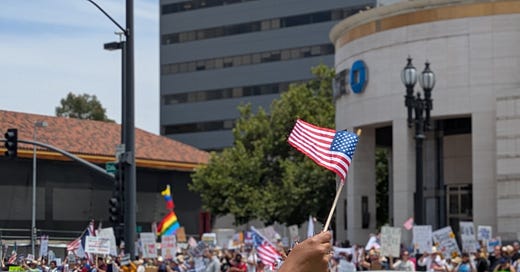Minga (Quechua)
Over the weekend, millions of people filled the streets in cities across the U.S. to express a basic tenet of any functioning democracy: protest.
I'm no political scientist, but we did interview one a few years back at Hidden Brain, and I learned that nonviolent resistance is surprisingly effective at bringing about change—about twice as effective as violent movements. A big reason for this is that violence tends to deter people, and lasting social change relies on large numbers of diverse groups of people coming together. Put simply, there are strength in numbers.
In South America, there’s an Indigenous word — minga — that loosely translates to something like, “collective work.” It involves community labor, care, and shared responsibility. Minga is, for example, a road repaired by neighbors or public gardens maintained by willing members of a community. Minga isn't just about cleaning up local neighborhoods, though. It involves resistance. Mingas have been organized around climate justice, land rights, and political accountability. In 2020, the Minga Indígena in Colombia saw thousands of Indigenous people march on foot across the country to protest violence. Reporting on the movement, a New York Times article described the word:
“Minga is an Indigenous word, one used long before the Spanish arrived in South America, to refer to an act of communal work, an agreement between neighbors to build something together: a bridge, a road, a government.
But minga has also come to mean a collective act of protest, a call to recover what a community believes it has lost: territory, peace, lives.”
Another article from the North American Congress on Latin America adds: “By calling their movement a minga, the Indigenous participants call attention to both the work that must go into politics and the idea that that work must be collective.”
It’s easy for politics to feel individual, isolating, and divisive. It becomes less about the policies and actions that affect others and more of a way to state where we fall on some ideological spectrum. Minga, and the protests we saw this weekend, are a reminder that behind every policy and headline, there are real people involved. And if change is going to happen at all, it probably starts there.
Share-worthy
The Hidden Brain episode mentioned, featuring the work of historian Erica Chenoweth, who has studied more than 100 years of revolutions and insurrections.
Working on that episode, I came across Srđa Popovićs TED Talk about his role in Otpor! a nonviolent activist movement that played a key role in the ousting of Slobodan Milošević.
Another Hidden Brain episode I worked on about revenge and how our desire for vengeance operates like an addiction in the brain.
RIP Brian Wilson, who died this week at the age of 82. I really enjoyed this 2021 documentary that followed his career but also documented the friendship between Wilson and Rolling Stone editor Jason Fine.
From the archives
What Does It Mean to Be ‘Lucky to Be Here’? (Medium, 2021)





I always learn so much from your work, Kristin. Thank you.